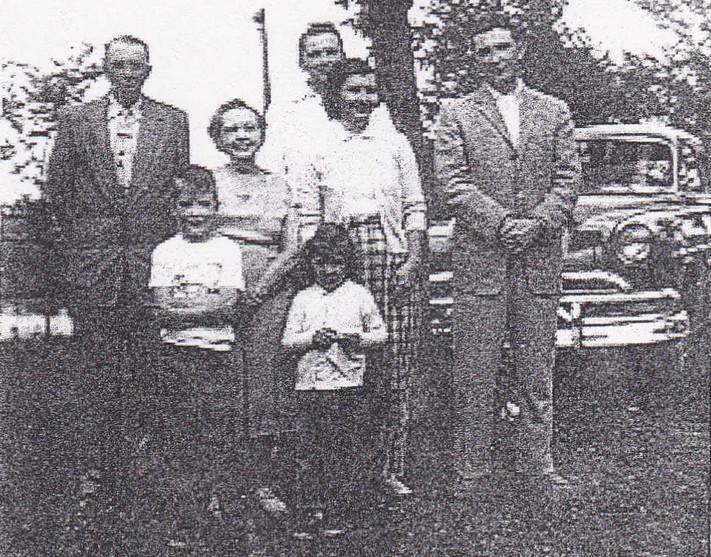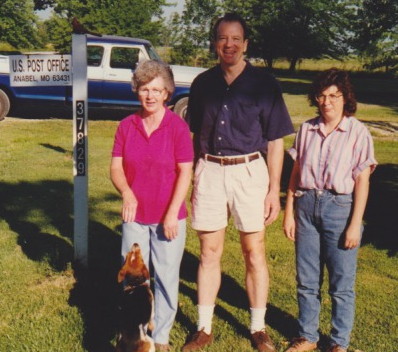
Email Us
Share your pictures, memories and stories

Middle Row: Charles and Alzoma Griggs & Virgina and Charles Marion Griggs (their children in front). Back: Varion Griggs.
Jean Maupin started the year as teacher, and was replaced mid-year by Charles Griggs.
Jean Margaret Maupin (1915-1987) was born near Clarence, Missouri, and presumably went to the Clarence High School. Little trace is found of her in the usual public records. Whether she was related to Simon Maupin, who once lived across the street from the school, is unknown, but she may have been. She is a descendant of Joel Rice Maupin, who was born in Virginia, and settled near Hannibal in about 1830. It is possible Simon was related to that branch of Maupins. How Jean got into teaching, and how many places she taught is unclear.
She married James J. Timbrook in Clarence, 20 January, 1951, according to the recorded marriage license. She is buried at the Shelbina Cemetery, Shelbina, Missouri, as Jean M. Timbrook.
The 1940 Census finds her married to Harold L. Davis and living in Clarence, Missouri. He was the proprietor of an electric appliance store. She is credited with one year of college at that time, and is an unpaid family worker, presumably in the store. Social Security records indicate she was known as Jean Maupin Davis in 1941, and reverted to Jean Maupin in 1945.
Miss Maupin was the first teacher hired at Bohannon School after the Trachta children began going there. Prior to teaching at Bohannon, she taught at other area rural schools, according to former students of Prairie Dale and Brammer. Her tenure at Bohannon involved a large measure of recreational activity, bingo games, softball games, and visits to neighboring schools. She left after one semester, and after gossip among the older children who believed they had detected performance deficiencies.
Charles Marion Griggs (1929-1994) was the eldest son of Charles Vaughn and Ida Alzoma Griggs, who ran the general store and post office in Anabel, the small rural town north of the school.
The elder Mr. Griggs was called Charlie, to avoid confusion, and his store was a youngster's wonder. There was a pot-bellied stove at the back, oiled wooden floors, shelves up to the ceilings that required a long-handled grabber to access, and candy jars by the cash register. They sold everything a farmer needed, and sometimes bought eggs and cream. Every child who visited got an all-day sucker from Charlie Griggs.
How the Griggs store handled its cash flow is a mystery that deepens as the years pass. Credit was extended to loyal customers, and goods were purchased on account. Payments were made as funds were available. It was a common custom in those days, in that area, at least, but seems unworkable in these less fraternal times.
Charles Griggs, the younger, was awaiting induction into the Army, at the time of his hire. After the school term ended he went into the paratroopers, and later returned home to take over the family business. He graduated from Macon High School and newspaper accounts indicate he was living in Columbia Missouri in April, 1948, probably attending the University of Missouri. After his stint as Bohannon teacher, he joined the Army and went to Korea. He landed in Japan in July, 1951, and by 1952 he was back at Ft. Breckinridge, Kentucky. After his return to Anabel, his wife Virginia took over the Post Master duties.
A visit to Anabel in 1996, after fifty years, found the old Griggs store closed, and gone, with nothing left but a vacant lot and a few trees. Charles had passed away the year before. Virginia Griggs, Charles' wife, was still the postmistress, but the post office had moved to a new building on the other side of the square. By the time of a return visit in 2003, the post office had closed.
Charles was an excellent teacher, and his efforts salvaged the year, filling the gaps in the students' education that had been opened in the first semester of bingo and frivolity.
This was the last year for Bertha Grace Graves at Bohannon. After graduating Macon High School in 1954, she married Forest Andrew Good, of Excello, Missouri.
The Rufener family was a force at Bohannon School during the 1950s. Lillie Mae Rufener had an older sister, Barbara, and two older brothers, Gene, and Jimmy, at Bohannon School in 1948-49. Over the next years a number of other Rufener boys attended. They lived on a farm about a mile east of the school, and managed to be the first arrivals on most days. They brought a presence, and leadership of a how-to-do-things variety. The school had a massive coal furnace, on the right as one entered, and a coal shed a few yards in front of the door. During the time the Trachta children attended, one of the Rufener boys was normally in charge of banking the fire at night, and keeping it stocked with coal during the day. During this year, that duty fell to Gene Rufener, another eighth grader who made it his business to watch out for the younger children.
Each day began with the Pledge of Allegiance and a sing-along. Bertha Grace played the piano and, since she played only by ear in those days, students were limited to songs she knew. That included most of the numbers in the songbook. She petitioned to play popular songs, but that was seldom allowed, for some reason.
This was the first year for Greg Trachta, the only first grader, who joined his brother at the school. It was also the year the Wray children showed up, newly arrived from Iowa, as well as the Griffith children, also from Iowa. The Griffiths moved to the old Tom Bohannon place (see 1918 plat map). The chaos of the first semester caused the reading circle to be abandoned for this year.

A 1996 visit to Anabel found the Post Office still open, with Charles' wife, Virginia (on left) still presiding. Her daughter, Nancy is on right.
My first year at Bohannon School was the most fun I ever had in school. The first semester was a lark. It must have involved more than this, but what I remember was a continuous run of bingo games, softball games, and bouncing here and there over the rutted dirt roads, to other rurual schools in Miss Maupins ancient, even for those days, car. Add to that the extended recesses, gossip about Miss Maupin's boyfriend, who showed up from time to time in the most amazing looking new Mercury, and the unending gossip among the older girls about her social life, and the short few months brought social stimulation never to be exceeded. My mother took charge of my education that year, with writing and arithmetic exercises after the cows were milked.
After Charles Griggs took over, academics resurged, but it was truly a relief. The exhausting pace of that first semester couldn't have been sustained. Charles was an excellent teacher, especially for beginners like me. His patience, explanations and scheduling were the beginning of my formal education.
January, 1949 was the year of the great Midwestern blizzard which left the entire outdoors thick with ice. The area was glazed over for weeks. Getting from house to barn was an expedition. A few kids, I believe Larry Walker and someone else, ice skated to school.
The Rufeners had their own ice-walking technique. The mowing machine was a common farm implement used to cut hay. Many farms had a few broken parts, and among the components were small, metal triangles from the sickle arm. The Rufeners, perhaps on the initiative of their relative, Dick Marsh, got them red hot, bent the corners into three-point cleats, and fastened them to their shoes. I remember Gene, and Jimmy Rufener heating sickle blades in the firebox of the school furnace, and outfitting several friends. They were more effective than ice skates.
One sterling memory of the Bohannon School environs was Allen Cox, and the mail delivery. The roads prior to the late 1950s were deplorable. Two-lanes paved was the scarce gold standard; a few others were graveled. The remainder, like the Bohannon School road, were narrow, dirt lanes, heavily rutted by the last wet-weather usage. They were best in the frozen winter, worst in spring. Tractors and horses could usually get through, but cars often couldn't.
Allen Cox was the locally famous mail carrier for many years. He'd invented a homemade vehicle that could get through in almost any road condition. It had huge tractor tires on the rear, was mounted high to avoid scraping while mucking through deep, wet ruts, and, with chains for traction, could manuever the ice and snow. A local measure of a storm was whether Allen Cox could made it through with the mail. He usually did. We'd love to have a picture of his "Anabel Puddle Jumper," but for now, we have to settle for this description from Elisabeth Graves, as told by Herschel Graves, from the website "Ancestry.com."
"Back before the county roads were paved (1950s), Allen Cox was the postal delivery person for the Anabel, MO area. He rigged up an old Model A vehicle that was called the "Anabel Puddle Jumper" -- a combination of a car and a tractor to traverse the mud & gravel roads. This vehicle was displayed at the Macon County Fairgrounds for the Fly Reunion in August 2011."